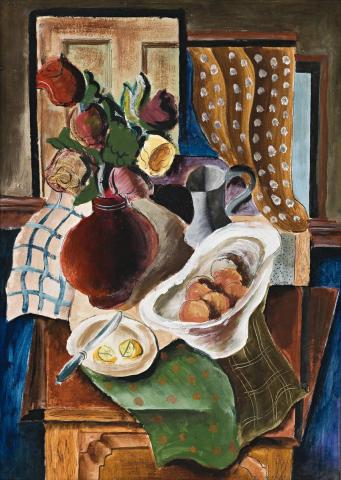STILL LIFE, 1937
RUSSELL DRYSDALE
watercolour, gouache, pen and ink on paper
68.5 x 48.0 cm
signed and dated lower right: Russell Drysdale ...7
The Estate of The Lady Casey, Melbourne
Probably Russell Drysdale, Riddell's Galleries, Melbourne, 26 April – 7 May 1938,cat. 10 or cat. 16
Inaugural Exhibition, Contemporary Art Society, National Gallery of Victoria, Melbourne, 6–25 June 1939, cat. 180 or 181
Nibbi, G., Art in Australia, Sydney,15 August 1939, p. 17
Dutton, G., Russell Drysdale, Thames and Hudson,London, 1964, pp. 20–21, 185, pl. 8 (illus.)
Klepac, L., The Life and Work of Russell Drysdale, Bay Books, Sydney, 1983, pp. 34, 201,pl. 12 (illus.)
As a young artist of tremendous talent, Russell Drysdale showed a lively interest in the modern movements in art. This was fed both by Melbourne's George Bell School and his several visits to Europe during the thirties where he gained first-hand experience of the work of the artists of the School of Paris. Reminiscing to Geoffrey Dutton years later, Drysdale said, 'Modern paintings which seemed to me quiet when I had seen them as reproductions shown to me by Bell, came as a sort of shock when I saw these things in galleries; quite suddenly they had a meaning which they never had in books.'1 When Drysdale showed two of his works with the Group Twelve Exhibition in 1937, George Bell's supportive review described his work as having 'great vitality'.2 Less than twelve months later, when Drysdale held his first solo show, Basil Burdett, the noted art critic for the Melbourne Herald, stated, 'I have seldom seen a more promising exhibition by a young painter anywhere.'3 Still Life,1937, the painting on offer, was among the works exhibited. Burdett acknowledged that Drysdale's 'eclecticism argues the obvious fact that Mr Drysdale has not yet found his own style ... [but shows] a healthy and wide range of interest in contemporary artistic thought and expression ...'4
The influences ranged through Cézanne, especially in figure subjects, and Fairweather, to Matisse, and Cubism to Picasso and Braque in particular, as seen in our painting, as well as Abstract, c1938, in the collection of the National Gallery of Victoria, Melbourne, and Still Life, 1939, once in the collection of Drysdale's teacher, George Bell. While each is a creative essay inspired by European masters, they show unmistakable individuality and the talent of an Australian master in the making as he moved towards his personal vision. Still Life, 1937 was inspired by the form of Braque and the colour of Matisse, within a lively, rhythmic composition imbued with the individual quality of the paint and its handler. Drysdale thought so highly of the painting that he included it in the inaugural exhibition of the Contemporary Art Society, which opened at the National Gallery of Victoria in June 1939. His two entries, both still life paintings, received special praise from Gino Nibbi in his review of the exhibition. Nibbi concluded, 'In [Drysdale's] work, the determination to isolate the colour reaches sometimes effects of lyrical incandescence.'5 Still Life, 1937 is one of a rare and particularly select group of early paintings. Maie (Lady) Casey, in whose collection it was for many years, was one of Drysdale's fellow students, having joined Bell's school in 1932.
1. Geoffrey Dutton interview with Drysdale, quoted in Klepac, L., The Life and Work of Russell Drysdale, Bay Books, Sydney, 1983, pp. 17-18
2. Bell, G., 'Vitality shown in pictures of Group', Sun, Melbourne, 16 June 1937, p. 42
3. Burdett, B., 'Modern art in Melbourne', Herald, Melbourne, 26 April 1938, p. 10
4. Ibid
5. Nibbi, G., Art in Australia, Sydney, 15 August 1939, p. 17
DAVID THOMAS
